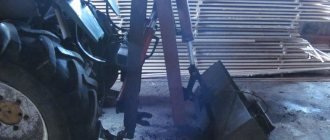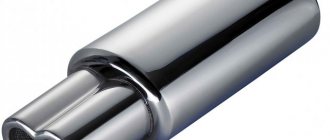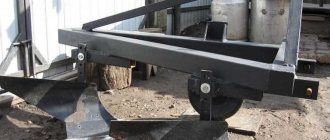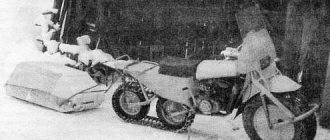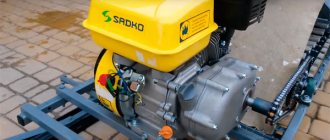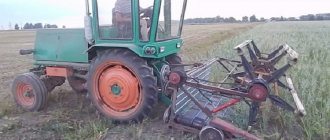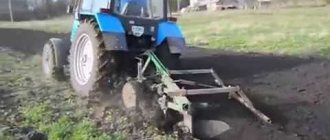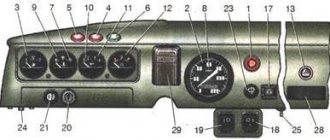Description of the mini harvester
A homemade mini harvester is essentially no different from its larger counterpart. Despite the fact that it is an additional piece of equipment, its functionality allows it to perform many different functions, including not only harvesting crops, but also planting; they are also often used to even knit sheaves.
All combines are equipped with a seat for the person who will operate it. But, if in large models it is presented in the form of a cabin, then for small ones there is only a small place where the operator can sit.
The device moves using three gears located directly in front and one, which is considered rear. It is worth noting that the cabin is equipped with several levers.
Each of them is responsible for its action and, accordingly, performs a specific function. For example, one of the most common is the adjustment of cut plants, that is, the cutting height on the ears can be adjusted.
This approach greatly simplifies work in areas with different terrain. Such a homemade grain harvester usually has a diesel engine, which does not have much power.
This means that the fuel consumption expected to be used will be quite moderate, which is undoubtedly a positive side for the owner.
Price and analogues
The Zarya combine is sold through existing factory representatives or private owners in Russia. The cost of equipment depends on the installation of the complete set, the location of the dealership center and the delivery method. The price of a new car is 150-350 thousand rubles. The standard purchase kit includes additional knives and consumables.
Among the harvesting analogues, German Claas, Chinese DongFeng and American John Deere are distinguished. Due to the installation of a luxury cabin, mini harvesters are much more expensive.
Advantages of mini harvesters
- The main advantage, undoubtedly, is the price of even purchased models from manufacturers. And having learned how to make a homemade combine harvester, it is quite possible to reduce its cost even more.
- Minimum fuel consumption, which at the input allows minimizing the price of the final product, which is important especially for cases where the raw materials are planned to be sold in the future.
- Due to its parameters, such equipment will not only always find its place in the household, but will also be quite maneuverable and efficient in operation.
- Since the device is small and does not have high power ratings, it can be used without any special permits or other documentation.
- The simplicity of the design allows you to repair equipment without resorting to the help of specialists, which means there is a significant cost savings.
Mini tractor based on a walk-behind tractor with an AM-4 adapter (8.5 hp, 6×12 wheels, differential)
The walk-behind tractor is equipped with a six-wheel gearbox on differentials and with a headlight!
Modern walk-behind tractor Shtenli
1030 is designed to perform a wide range of work: harrowing, inter-row cultivation, soil plowing. The walk-behind tractor belongs to a new generation of agricultural machinery and can be used by both professionals and amateurs.
Four-stroke engine with 8.5 horsepower, makes Shtenli
even more reliable. The special shield of the working cutters guarantees the operator’s protection during the cultivation process from dirt, lumps of soil and stones.
The universal walk-behind tractor is very economical, as it consumes little gasoline. The spacious fuel tank allows you to work continuously without being distracted by refueling.
Powerful pneumatic wheels measuring 6.0x12 increase the stability of the cultivator. High tire tread allows the use of a reliable Shtenli
1030 as a tractor. The balance of the handle and the weight of the drive creates comfortable conditions for the driver during operation. The ability to adjust “for the operator” adds convenience in cultivating the land. If necessary, the handles can be moved to the side. This way you will walk on the side of the cultivator and not trample previously cultivated soil.
Classification of mini harvesters
- Small ones. Such devices do not include a seat and are controlled from the rear using a principle that is similar to a lawn mower. The dimensions of the header, or rather its grip, in this case do not exceed one meter.
- Average. This size of equipment already includes a seat for the person who will operate it. Here is a more significant characteristic of the width of the header, which already exceeds a meter.
Products
The brand produces a large number of agricultural equipment, the most popular being tractors, precision farming systems and combines.
Today the following series of tractors are produced:
- 6G.
- Episode 9 TTV.
- Episode 6.
- Episode 7
- Agrotron X720.
- Agrotron L720.
- Agrotron M620.
- Agrotron 180.
- Agrotrac 130/150/170.
- Agrofarm G115.
- Agrofarm G410/430.
- Agrolux 4.80.
- 6W Profi.
- Agroclimber F.
- Agroclimber.
- Agroplus FVS.
Precision farming systems are used in many modern agricultural enterprises. Automated control and synchronization of operations significantly increases work efficiency. Deutz-Fahr offers reliable and highly precise automation. The precision farming system from Deutz-Fahr is:
- Reception of signals using all satellite systems, including corrective ones.
- A single interface for all processes and applications. Its diagonal can be 8 or 12 inches.
- Steering systems are represented by visual, power steering.
- High-precision sectional control that eliminates overlaps and skips.
- Possibility of complete automation of data management.
- A security system for large tractors has been introduced; the cameras have a wide viewing angle.
Combines:
- S9000 series.
- HTS 6060//6095.
- C6000.
Potato harvester
A homemade potato harvester, as a trailer, complementing a mini tractor, as an attachment, or directly as a self-propelled vehicle operating on the basis of a walk-behind tractor.
Its main device is a lifter, which lifts tubers from the ground to the surface.
It installs two functions.
- The first is responsible for working at a certain depth, preventing the combine from digging too deep or, conversely, superficially.
- And the second is responsible for the angle of inclination, due to which the potatoes then fall into the next compartment. In it, vegetables are cleaned of excess soil.
This compartment is called a sifter. The sifter has another important function. In this department, potatoes are divided directly by size. The large one ends up in a special department.
MSU type
The most “expensive” mistakes are made at the stage of choosing a car, says technical marketing director Dmitry Inozemtsev. According to him, there is nothing worse than an expensive, underloaded combine. “Unfortunately, our consumer does not delve into the subtleties of choice due to low awareness, while the European consumer is more scrupulous, he will not overpay, but at the same time he is ready to spend money on expensive equipment, saving on the cost of ownership and optimization of cleaning,” the specialist compares .
At the same time, they forget that if the equipment or option is not installed at the factory, it becomes 15-20% more expensive: the delivery price is added, the complexity of installation, design, packaging, etc. increases, adds the director of sales development at SAME DEUTZ-FAHRRUSSIA Alexander Shcherbik.
At the selection stage, it is important not to make a mistake in the type of combine and correctly select the appropriate threshing and separating device (MSD). The productivity of the harvesting machine is the most important point allowing the agricultural producer to meet the required deadlines
Today, the market offers drum (single or double drum with a key straw walker), rotary and hybrid (with a drum thresher and rotary straw separator) machines. Rotary ones are more productive, drum ones are more versatile. The basis for the choice is a correct assessment of the yield of the fields, as well as the set of crops in the crop rotation. Threshing in a drum (keyboard) combine occurs due to impacts on the grain mass, while in a rotary combine it occurs due to friction between the layers of the mass itself (similar to washing clothes in a centrifuge, where the lower layer of the mass rotates more slowly and the upper layer faster).
Thus, for the effective use of rotary combines, a large mass flow is required, and therefore high yields, notes Ivan Morzhakov, a specialist in combine harvesters at John Deere. A typical mistake would be to purchase such machines for work in regions with a yield below 40 c/ha, the specialist warns: insufficient loading of the rotor with mass will lead to a decrease in the quality of threshing, increased grain crushing and, in general, will not allow the full potential of the rotary machine to be revealed.
It is equally important to evaluate the cleaning conditions and climatic features of the region when choosing a keyboard machine. For example, under frequently recurring non-ideal conditions (high humidity of the mass, contamination, etc.)
etc.), it is better to focus on a double-drum machine, advises Sergei Sozinov, marketing and sales specialist for harvesting equipment. One drum copes worse with the moistened mass, he explains, while the second (essentially a centrifugal separator) helps him with the main separation.
There is also the option of hybrid machines (for example, CLAAS combines), which implement a double-drum threshing system with rotary separation. This is a compromise and universal option that can be used in both adverse and dry working conditions. However, if the field is heavily clogged, it is not recommended to use either a hybrid or a rotor, as they are sensitive to variable humidity, adds Maria Minaeva, a specialist in combine harvesters and forage equipment at John Deere. For such fields, keyboard machines are more suitable.
Berry harvester
Berries and the bushes where they grow are more delicate plants than, for example, grain, so their collection should be done a little differently.
A homemade berry harvester should be made in such a way as to minimize the damage caused to plants during harvesting.
But with all this, craftsmen are ready to create such a useful device in no more than ten minutes.
- For this you will need plywood.
- First, a small ring is cut out, which should be blind, with a diameter of 15 to 18 cm, and also a second one with identical dimensions, but similar in appearance to a regular wheel. They are fastened together by overlapping each other.
- After that, small holes are drilled around the entire circumference, the diameter of which is no more than 5 mm.
- Next, you will need small sticks, whose length should be 40 cm. As a result, we will make a small combine, which is sometimes also called a comb. Such sticks are fixed at one end with a blind disk.
Fans of wild berry picking manage to make a harvester even from the simplest plastic bottle. This simple invention will significantly increase the efficiency of berry picking.
Self-production
In order to successfully produce this kind of equipment, you will need to decide on the desired model, as well as acquire its drawings. After this, it is enough to make sure that all the necessary materials and tools are available, which will allow you to immediately begin the assembly process.
Harvesters differ by type of mechanism
Required tools and materials
The assembly of the product will be completed successfully if you make sure in advance that all the necessary materials and tools are available. The simplest combine harvester can be made from available elements, among which it is advisable to note:
- metal profile;
- fittings;
- steel rods;
- wheels from old vehicles;
- pipe;
- ball or roller bearings;
- gears and chain;
- fasteners.
During the assembly process, the master will need a standard set of tools, as well as an angle grinder, a welding machine, a powerful drill and measuring instruments. It is extremely important to carry out all fixed connections of the structure by welding, which will ensure its reliability and long service life.
In order to make the design more accurate, you can use a drilling machine instead of an electric drill.
Blueprints
The choice of a suitable device model that you plan to assemble is of great importance. It must correspond to the available materials, but the master, if desired, can make changes to its design, which will allow him to adapt the constructed product to solve specific problems.
Assembly order
The assembly of a homemade combine harvester takes place in several main stages, the first of which is the manufacture of the frame. It should be rectangular in shape, and its base is a steel profile. You will need to attach the snare drum to it, as well as a support for the drive shaft.
Be sure to read: Characteristics of the SKD-6 Sibiryak combine harvester
It is highly recommended that the frame be constructed to be heavy in weight to minimize vibration during operation. For further assembly, please adhere to the following instructions:
- Make a frame for a grain drum. To do this, you can use pieces of steel corners that will need to be welded to the rims. The latter can be taken from old domestic cars, for example, Moskvich or VAZ. In this case, the end parts of the elements are cut off and the rings are welded.
- Place reinforcement bars between the corners and attach them using a welding machine.
- Assemble the shaft using a strong metal pipe of the required size. Place it in 2 supports that are attached to the frame of the unit. In this case, the shaft must be equipped with a gear, which will be used for a chain drive.
- Equip the drum with an outer casing, which is best made using a 200 liter steel barrel. Its upper part must be dismantled, which will allow quick cleaning or repair work if necessary.
- Drill holes for discharging grain, connect the halves of the casing using several bolts.
- Install the drive shaft on the frame; if desired, mount the gearbox on the opposite side of the unit. Mount the chain, paying special attention to its correct tension, which will prevent it from slipping during operation.
- Cover the chain with a protective casing, which can be made of steel or other materials, which will extend its service life.
- Mount a steel grate under the drum, which will allow straw to be collected.
Such a device appears to be a homemade drum-type harvester. It can operate by connecting to the tractor's power take-off shaft or to the rear axle.
Photo of a homemade combine harvester
How different models work
Depending on the design of the threshing separating unit, threshing devices are:
- rotary type;
- drums;
- mixed.
The features and mechanism of work of these groups can be considered in more detail.
Rotary
In the design of a rotary machine, the threshing unit is represented by a rotor. Rotating, it creates centrifugal force, which contributes to threshing of grain. These are convenient and productive combines, so they are perfect for processing large, high-yielding fields. An additional advantage is low labor intensity, reduced number of drives and rotating mechanisms. However, there are some disadvantages:
- the equipment cannot work with wet raw materials;
- The machines show their greatest performance only in dry, hot areas;
- expensive maintenance and increased resource consumption.
Note! The rotary grain harvester is suitable for large agricultural enterprises. Since the price of such equipment is high, it is not advisable to purchase it for personal use.
Drums
The design of such combines (they are also called keyboard harvesters) can be called classic. At the front of the machine there are knives that cut the chaff and transfer it to the reel. It collects the stems and moves them to the header. With the help of rotating augers, the ears are moved into the conveyor pipe, and then into the threshing department. The threshing drum threshes the raw materials. The portion separated from the chaff is poured onto the screen through the deck, and the unthreshed parts undergo another processing. In this case, the stems are cut or go into a storage bin, and the grains are winnowed and poured into a special compartment. From there they can be poured into truck bodies. At the same time, the productivity of drum technology is two or three times less than that of rotary technology.
Hybrid
These threshing machines are used to collect not only grains, but also legumes. The machines combine threshing mechanisms of rotary and keyboard technology. Hybrid agricultural machines differ in their functionality from drum machines, but the straw husking itself occurs in the rotor, where the grain and stem parts are supplied after processing in the drum. The structure of the rotors is lattice, so the threshed grains are poured directly onto these grids, then ending up in the receiving compartment.
Popular manufacturers
Domestic and foreign manufacturers produce various cleaning equipment
When choosing a small-sized agricultural machine, special attention is paid to its technical characteristics, ability to aggregate attachments and brand popularity
Mini-harvesters for grain harvesting Zarya MZK-800 from a Russian manufacturer are considered the best for areas of 5-6 hectares. They do not sag on the field and do not form ruts in loose and wet soil.
Low fuel consumption, design features of the location of working units, excellent maneuverability are the main advantages of the model. The ability to attach any adapter allows you to turn the grain combine into a forage harvester or into a machine for harvesting barley, corn, and sunflower.
The self-propelled tractor is equipped with a 4-cylinder diesel engine with an output of 85 hp. pp., which ensures low resource consumption - 400 ml per 1 hour of operation. Its working volume is 3.8 liters.
The difference between the MZK-800 and other models is the absence of a cabin. Structurally, an awning was developed for the mechanism, attached above the driver’s workplace using special racks.
Technical parameters of MZK-800:
- travel speed - 20 km/h;
- threshing size - 500 mm;
- mowing height - 50-800 mm;
- processing width - 2350 mm;
- fuel consumption - 0.4 l/h;
- productivity - 600 m²/h;
- dimensions - 8500x2900x3300 mm.
John Deere
A representative of mini-agricultural equipment is the JohnDeere-942 miniature grain harvester, which appeared on the market back in 1979. Since 1983, car production has been suspended.
The mechanisms are adapted to Russian operating conditions and are capable of working on uneven areas with a slope of up to 22°. The combine operator's workplace is well organized and comfortable. The combine is equipped with a 75-horsepower 4-cylinder diesel engine and a 3-speed transmission.
- operating speed - 10 km/h;
- width of the threshing device - 300 mm;
- power unit volume - 0.39 m³;
- working width - 3000 mm.
The disadvantages of the model include the high cost of the tractor.
Farmer
The Farmer mini grain harvester, which is used to harvest 9 types of industrial crops, is gaining popularity in the domestic market. The module is equipped with one drum and an 85 hp motor. With. and mechanical transmission. The maximum speed of the unit reaches 20 km/h, operating speed is 10 km/h.
The Farmer mini-harvester has a comfortable cabin with an installed ventilation air cooling system and good visibility. Inside there is a radio and radiotelephone.
Harvester technical characteristics:
- total weight - 4600 kg;
- overall dimensions - 8500x2900x3300 mm;
- engine power D 243-91 - 85 hp;
- header working width - 2.3 m;
- grain tank capacity - 3 m³;
- productivity - 3 kg per second.
Claas
German Claas combines are considered leaders in the world market. They meet the requirements of European standards and safety standards, have excellent performance, high performance and reliability.
Features of the Claas Consul model range:
- threshed - 106 cm;
- Perkins engine power - 68 hp. With.;
- hydrostatic drive;
- 3-tier box.
Important TOP 3 Salyut cultivators with high engine life
Grain bins - 3 m³, the height of the unloading auger is adjustable, which makes it easier to unload grain from threshing into bags.
Technical and operational parameters of the model:
- header processing width - 3010 mm;
- operating speed - 1.6-20.4 km/h;
- engine displacement - 3.8 l;
- productivity - 2-2.5 ha/h.
Dongfeng
Among the large range of Chinese products, the Dongfeng-1548 combine harvester stands out.
Dimensional and weight parameters of the model:
- total weight - 2175 kg;
- length - 5100 mm;
- width - 1900 mm;
- height - 2400 mm;
- header working width - 2000 mm.
The mini-harvester is equipped with a diesel engine with an average power of 53 hp. With. Adapters in the form of a seeder and a mechanism for tying sheaves are hung on the device. The productivity of crop processing reaches 0.53 ha/hour. Bunker volume - 0.8 m³.
- low cost;
- possibility of unloading into dump trucks;
- high performance.
The disadvantages include:
- oil leak;
- rapid wear of parts;
- increased fuel consumption in difficult areas.
Is it possible to do it yourself
Due to the high cost of equipment, some farmers make a homemade mini-harvester on their own. Any tractor, for example T-40, is taken as a basis. The design allows it to be used for cleaning work: a strong motor, a ready-made wheel frame and even a seat.
The main problem is the installation of the header. The attachment adapter is purchased in working condition. Trailed KPKU-75 is often purchased.
To improve balancing, use counterweights installed at the rear of the tractor: a tank of water or gas cylinders.
AGCO Fendt Ideal 9T
The presented model is one of the largest grain harvesters assembled in North America. An even more massive version of the Ideal 10 is available for the European market.
The grain harvesting equipment is equipped with a hopper with a capacity of 17 thousand liters. Unloading is carried out at a speed of 210 liters per second.
Under the conventional hood there is an engine from MAN with a volume of 15.2 liters and a power of 560 horsepower. Power can be increased to 647 horsepower.
To ensure improved cross-country ability, the equipment is equipped with caterpillar tracks. Can provide exemplary performance when harvesting in rain.
The equipment is equipped with a thresher with a pair of Dual Helix rotors, which allows you to achieve high quality grain and straw. At the same time, the thresher has a wide range of adjustments to adapt to specific working conditions.
It takes less than 1.5 minutes to completely unload an entire grain bin, namely 1 minute and 20 seconds.
An excellent option for cleaning large fields in regions with rainy weather.
The list of candidates does not end there. There are plenty of other good combine harvesters on the market.
But there is no doubt about the efficiency, quality and performance of the models and manufacturers reviewed. It is not for nothing that they are widespread not only in Russia, but also in Europe, the USA and Asian countries.
Important How to make and install a car lift for a garage yourself
What brands of agricultural machinery do you know? Who do you prefer and why? Do you have experience working with combine harvesters? What other good models and companies do you know?
We are waiting for your answers, as well as stories from personal experience.
Subscribe, leave comments, ask questions and tell your friends about the project!
